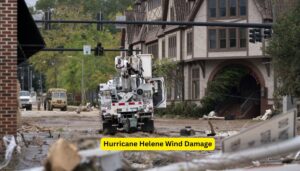Biltmore House and the Impact of Hurricane Helene: A Detailed Examination of Asheville’s Historic Gem
The Biltmore House, a historic marvel in Asheville, North Carolina, has long been an architectural and cultural icon. Its impressive architecture and extensive gardens attract millions of visitors each year, but the estate has also faced various environmental challenges, with hurricanes being one of the most significant. Hurricane Helene stands out among these natural events, causing notable damage to the Biltmore grounds. This article dives into the history, beauty, and resilience of the Biltmore House, focusing particularly on how Hurricane Helene impacted this estate and its surrounding area.
A Glimpse into the Grandeur of Biltmore House
Nestled in the Blue Ridge Mountains, the Biltmore Estate spans over 8,000 acres and showcases remarkable architecture, landscaped gardens, and historically significant interiors. The estate was completed in 1895 by George Washington Vanderbilt II, who sought to create a retreat that embodied European elegance in the heart of Appalachia. With 250 rooms, including 43 bathrooms, 65 fireplaces, and an array of luxurious indoor features, Biltmore House remains one of the most significant privately-owned homes in the United States.
The estate attracts visitors not only for its architectural splendor but also for its rich history and preservation efforts. The gardens, designed by Frederick Law Olmsted, include a vast array of plant species, reflecting the harmony between architecture and nature. The Biltmore Estate serves as a major cultural and historical site, hosting various exhibitions, seasonal events, and cultural activities, which are essential for sustaining local tourism.
The Devastating Impact of Hurricane Helene on Asheville and Biltmore House
In 2018, Hurricane Helene, a powerful tropical storm originating in the Atlantic, reached Asheville, North Carolina, causing extensive damage. Although Asheville is inland and less prone to direct hurricane hits, the remnants of storms often bring heavy rain, winds, and flooding. Hurricane Helene’s impact on the Biltmore Estate was especially significant due to the estate’s sprawling acreage and its delicate balance with nature.

Heavy Rain and Flooding: Nature’s Test on the Estate
The most profound impact of Hurricane Helene was the torrential rainfall, leading to flash floods in and around Asheville. While the Biltmore Estate has substantial drainage and flood prevention measures in place, Helene’s intensity pushed these systems to their limits. The historic gardens and grounds suffered from waterlogging, causing soil erosion that required extensive rehabilitation.
In certain areas, flooding reached the interiors, raising concerns about potential damage to historical artifacts, furniture, and other invaluable possessions within Biltmore House. The preservation team acted swiftly to prevent lasting damage, but some repairs and restorations were inevitable.
Wind Damage: A Threat to Architectural Marvels and Landscape
The winds from Hurricane Helene were relentless, uprooting trees and damaging the foliage across the estate’s gardens. The Italian Garden, renowned for its reflective ponds and sculptures, saw significant disruption, with tree branches littering the paths and ponds. Even the Shrub Garden, which includes rare plant species, experienced damage that required immediate attention. This forced the Biltmore team to not only clean up debris but also protect vulnerable species affected by the storm’s aftermath.
While Biltmore House itself is fortified against extreme weather, the storm caused some minor structural concerns. Restoration teams inspected the chimneys, window fixtures, and roofing to ensure the building’s integrity and safety, essential for such an old structure.
Biltmore’s Resilient Recovery Efforts
Following Hurricane Helene, the Biltmore Estate administration, along with skilled conservators, gardeners, and architects, undertook rigorous recovery and restoration efforts. This complex process highlighted the estate’s commitment to preserving its historical, architectural, and environmental legacy, even in the face of severe natural adversity.
Landscape Restoration and Reforestation
Restoring the landscape of Biltmore Estate was a massive undertaking. Given the damage to plants, trees, and soil, horticultural experts were brought in to assess the condition of affected areas. The replanting of uprooted trees, replacement of eroded soil, and careful restoration of damaged paths were completed over several months. The estate’s environmental team worked closely with botanists and landscape architects to ensure that the restoration did not disrupt the natural ecosystem that defines Biltmore’s gardens.
Preserving the Architectural Integrity of Biltmore House
The Biltmore team took swift action to address potential structural concerns. While Biltmore House is resilient, any signs of weakness from external events like Hurricane Helene demand immediate attention. The roofing, windows, and decorative elements underwent comprehensive inspections. Specialized artisans were hired to ensure any repairs matched the estate’s historical and architectural essence. The dedication to preserving the Biltmore’s authenticity is a testament to the estate’s historical value and its importance to the Asheville community and beyond.
Water Damage Control and Artifact Preservation
The estate’s preservation team acted promptly to mitigate water damage within the Biltmore House. Dehumidifiers, fans, and other climate-control equipment were deployed to prevent moisture build-up. Historical artifacts, including furniture, textiles, and artwork, were carefully inspected and relocated if necessary to protect against potential damage. The response time of the preservation team was instrumental in ensuring that the historic interior and valuable collections remained safeguarded against the storm’s residual effects.
The Importance of Biltmore Estate’s Resilience to Asheville and Tourism
As one of Asheville’s primary tourist attractions, the Biltmore Estate plays a vital role in the local economy. Any damage or disruption due to hurricanes has a ripple effect on tourism revenue, impacting local businesses, jobs, and infrastructure. The estate’s quick and efficient response to Hurricane Helene ensured that it could reopen to the public without significant delays, thereby minimizing the economic impact.
Educational Programs and Conservation Awareness
The Biltmore Estate has also used these events as opportunities to educate the public on the importance of preservation and conservation. Through workshops, guided tours, and educational programs, visitors can learn about the challenges posed by natural events like hurricanes and the importance of proactive preservation efforts. The estate’s engagement in these educational initiatives reflects its commitment to sustainability and historical integrity.
Future-Proofing Biltmore Estate Against Natural Disasters
In light of increasing climate change concerns, the Biltmore Estate has taken steps to bolster its resilience against future natural disasters. Investing in advanced weather monitoring systems, drainage improvements, and updated emergency protocols are part of the estate’s comprehensive strategy to ensure that it remains protected. This foresight and investment in infrastructure are crucial for preserving the Biltmore House for future generations, ensuring that it can withstand the unpredictable forces of nature.
Read More – Hurricane Helene Missing People List Google Doc
Collaboration with Environmental Experts
The Biltmore Estate has collaborated with environmental scientists and meteorologists to enhance its preparedness for severe weather. By studying patterns and assessing risk factors, the estate’s management team is better equipped to protect this historical landmark from future events similar to Hurricane Helene. This proactive approach has set a precedent for other historical sites facing similar challenges, showcasing how heritage preservation and environmental adaptation can coexist.
Conclusion
The Biltmore House, with its grandeur, historical importance, and architectural prowess, stands as a resilient symbol of Asheville’s heritage. Although Hurricane Helene presented challenges, the estate’s recovery and restoration efforts have reinforced its strength and commitment to preservation. This historic estate is a testament to human ingenuity and the relentless dedication to cultural heritage, proving that it can endure nature’s tests while inspiring future generations.

